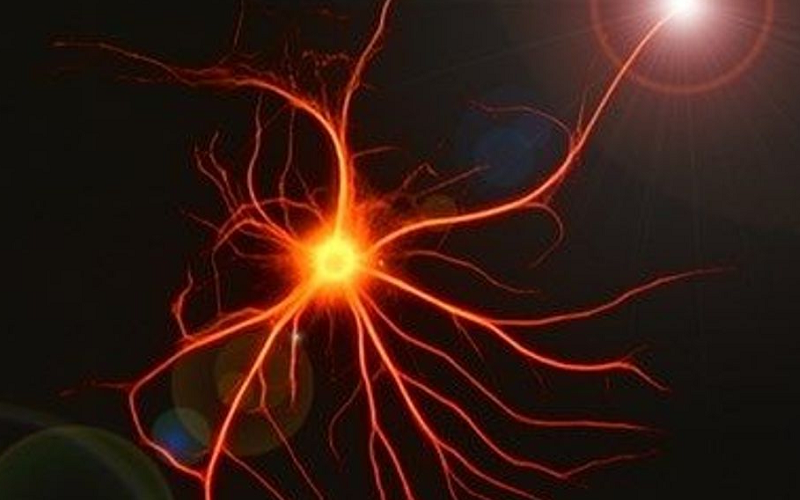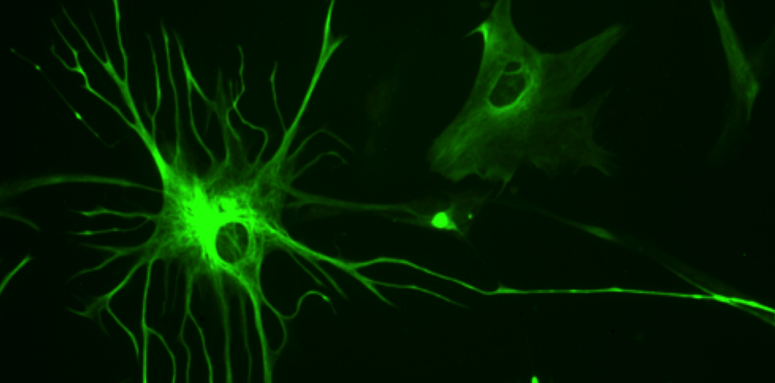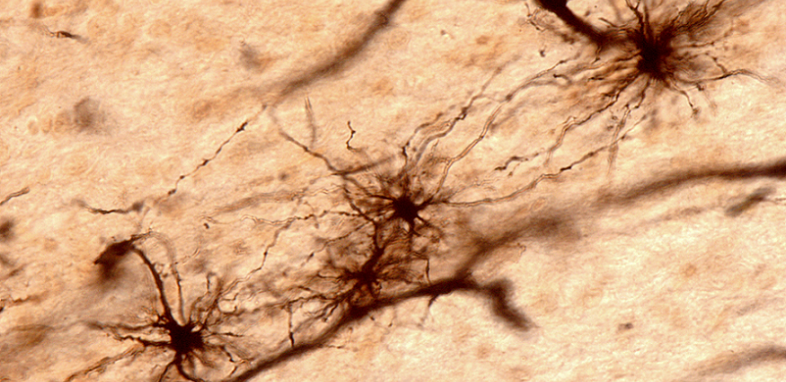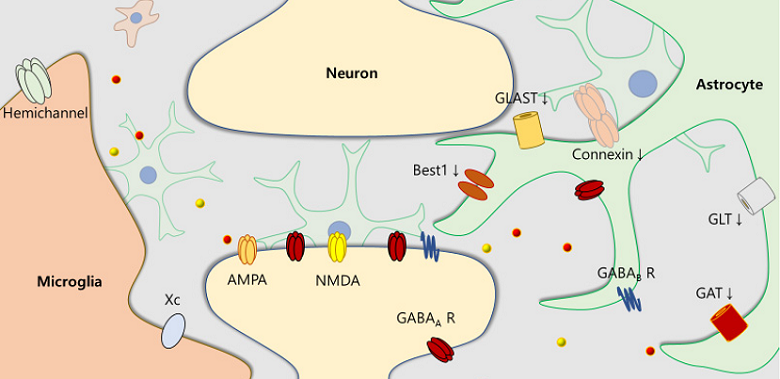
The brain, often referred to as the body’s command center, is responsible for our cognitive function, emotions, and overall health. To ensure optimal performance, it is crucial to maintain the delicate balance within this complex organ. Although neurons have long been the focus of neuroscience, a deeper understanding of the brain’s supporting cast is crucial to unlock the mysteries of our cognitive abilities and brain health. One such group of supporting actors is the astrocytes, a type of glial cell that plays an essential role in maintaining brain function.
Contents
- An Overview of Astrocytes
- Astrocytes Support Neuronal Activity
- Astrocytes Maintain Brain Homeostasis
- Astrocytes Role in Neuroplasticity and Brain Repair
- Astrocytes in Neurodegenerative Diseases
- Future Research and Therapeutic Applications of Astrocytes
- Nutritional Supplements That Benefit Astrocytes
- References
An Overview of Astrocytes
Astrocytes are a type of glial cell found in the central nervous system (CNS), comprising approximately 20-40% of the brain’s total cell population. Named for their star-shaped appearance, these cells possess a complex structure with numerous branching processes that extend out to interact with neurons, blood vessels, and other glial cells. Astrocytes are a heterogeneous group, with different subtypes exhibiting distinct morphologies and functions depending on their location within the brain.
Distribution and Diversity of Astrocytes in the Brain
Astrocytes are widely distributed throughout the brain, with varying densities depending on the specific brain region. They can be broadly categorized into two main subtypes: protoplasmic astrocytes, found mainly in the grey matter, and fibrous astrocytes, primarily located in the white matter.
Protoplasmic astrocytes have a more complex branching structure, allowing them to interact with multiple neurons and blood vessels simultaneously. In contrast, fibrous astrocytes exhibit a less complex morphology and primarily interact with the myelinated axons of neurons.
Functions of Astrocytes in the Brain
Astrocytes play a diverse array of roles within the brain, contributing to various aspects of cognitive function and brain health. They are critical for supporting neuronal activity by modulating synaptic transmission, regulating neurotransmitter release and uptake, and even participating in synapse formation and maintenance [1].
Astrocytes contribute to maintaining brain homeostasis by regulating ion concentrations, pH balance, and maintaining the blood-brain barrier. They also provide metabolic support to neurons by supplying nutrients and facilitating energy metabolism. Furthermore, astrocytes are involved in neuroplasticity and brain repair, playing roles in neurogenesis, injury response, and scar formation. These diverse functions make astrocytes indispensable for the proper functioning of the brain and the maintenance of cognitive abilities.

Astrocytes Support Neuronal Activity
Astrocytes interact extensively with neurons, playing a pivotal role in supporting and modulating neuronal activity. Their close proximity to neurons enables them to respond to and influence neuronal signaling, as well as participate in essential processes that maintain cognitive function.
Astrocyte-neuron Interactions
Astrocytes are intimately involved in modulating synaptic transmission, the process by which neurons communicate with one another. They can sense neuronal activity by detecting changes in extracellular neurotransmitter levels and respond by releasing signaling molecules called gliotransmitters, which can either enhance or inhibit neuronal communication. This dynamic interaction between astrocytes and neurons, referred to as the “tripartite synapse,” is crucial for fine-tuning synaptic transmission and maintaining proper brain function.
Astrocytes also play a vital role in regulating neurotransmitter levels within the brain [2]. They express specific transporters that enable them to uptake neurotransmitters, such as glutamate and GABA, from the extracellular space, preventing excessive accumulation that could lead to excitotoxicity and neuronal damage. Additionally, astrocytes can modulate the release of neurotransmitters from neurons by responding to changes in neuronal activity and adjusting their own gliotransmitter release accordingly.
Role of Astrocytes in Synapse Formation and Maintenance
Astrocytes contribute to the formation and maintenance of synapses, the specialized junctions where neuronal communication occurs. They secrete various extracellular matrix molecules and signaling factors that promote synapse development, stability, and plasticity. Additionally, astrocytes can directly influence synapse formation by extending their processes to engulf and enwrap nascent synaptic contacts, facilitating the establishment of functional connections between neurons.
Involvement in Long-term Potentiation and Learning
Long-term potentiation (LTP) is a process by which synaptic connections are strengthened over time, contributing to learning and memory formation. Astrocytes have been implicated in the regulation of LTP by modulating the availability of key signaling molecules, such as glutamate and D-serine, which are necessary for the induction and maintenance of LTP. By regulating these molecules, astrocytes can directly influence learning and memory processes, further emphasizing their importance in supporting cognitive function.
Astrocytes Maintain Brain Homeostasis
Astrocytes play a crucial role in maintaining the brain’s homeostasis, ensuring a stable and healthy environment for neurons and other brain cells to function optimally [3]. Their contributions to brain homeostasis can be divided into several key areas:
Regulation of Ion Concentration and pH Balance
Astrocytes are responsible for maintaining the delicate balance of ions in the brain’s extracellular environment. They express various ion channels and transporters that allow them to regulate the concentration of ions, such as potassium, sodium, and calcium. By controlling ion fluxes, astrocytes help maintain proper neuronal excitability and prevent neuronal dysfunction. Additionally, astrocytes contribute to maintaining the brain’s pH balance by regulating the levels of protons and bicarbonate ions, ensuring a stable environment for neuronal signaling.
Blood-brain Barrier Maintenance
The blood-brain barrier (BBB) is a highly selective barrier that separates the brain from the circulatory system, protecting it from harmful substances and maintaining its unique environment. Astrocytes play a vital role in the formation and maintenance of the BBB by extending their end-feet processes to surround blood vessels, creating a tight seal. They also release various signaling molecules that influence the permeability and functionality of the BBB, ensuring the brain receives the nutrients it needs while keeping out potentially harmful substances.
Metabolic Support for Neurons
Astrocytes provide essential metabolic support to neurons by supplying them with nutrients and facilitating energy metabolism.
Nutrient provision
Astrocytes take up glucose from the blood and convert it into various energy substrates, such as lactate and pyruvate, which can then be utilized by neurons for energy production. Additionally, astrocytes can store glycogen and break it down to supply neurons with glucose during periods of increased energy demand or glucose scarcity.
Energy metabolism and lactate shuttle hypothesis
The lactate shuttle hypothesis proposes that astrocytes play a key role in energy metabolism within the brain by producing and shuttling lactate to neurons for use as an energy substrate. According to this hypothesis, astrocytes take up glucose, convert it to lactate, and then release lactate into the extracellular space, where it can be taken up by neurons and used for energy production. This process highlights the importance of astrocytes in maintaining the energy demands of neurons and supporting overall brain function.
Astrocytes Role in Neuroplasticity and Brain Repair
Astrocytes are actively involved in processes related to neuroplasticity, the brain’s ability to adapt and reorganize itself in response to experiences and challenges [4]. They also play a crucial role in brain repair following injury or disease. Their contributions to these processes can be divided into several key areas:
Astrocytes’ Involvement in Neurogenesis
Neurogenesis, the process of generating new neurons from neural stem cells, occurs throughout life, albeit at a reduced rate in adulthood. Astrocytes contribute to neurogenesis by releasing growth factors and signaling molecules that promote the survival, differentiation, and integration of new neurons into existing neural networks. In addition, some astrocytes can transform into neural stem cells under specific conditions, further contributing to the generation of new neurons.
Reactive Astrocytes and Their Role in Injury Response
Following brain injury or disease, astrocytes become activated and undergo a process called reactive astrogliosis. Reactive astrocytes exhibit changes in gene expression, morphology, and function, allowing them to respond to the damage and initiate repair processes. They can release pro-inflammatory and anti-inflammatory molecules to modulate the local immune response, clear debris from damaged cells, and promote neuronal survival and regeneration.
Contribution to Scar Formation and Tissue Repair
Astrocytes play a vital role in scar formation and tissue repair following brain injury. Reactive astrocytes can proliferate and migrate to the site of injury, where they form a glial scar that serves to contain the damaged area and prevent the spread of inflammation and cell death. The glial scar also provides a scaffold for regenerating axons to grow and re-establish connections, facilitating functional recovery. However, excessive scar formation can also inhibit axonal regrowth and impede recovery, highlighting the need for a delicate balance in astrocyte-mediated repair processes.

Astrocytes in Neurodegenerative Diseases
Astrocytes are increasingly recognized for their involvement in the pathogenesis of various neurodegenerative diseases [5]. Dysfunction of astrocytes can contribute to the onset and progression of these diseases, while targeting astrocytes may offer potential therapeutic avenues.
Alzheimer’s Disease
In Alzheimer’s disease, the most common form of dementia, astrocytes exhibit various alterations that may contribute to disease progression. These include the accumulation of amyloid-beta plaques, a hallmark of the disease, which can trigger astrocyte activation and lead to the production of pro-inflammatory molecules. Additionally, astrocytes in Alzheimer’s disease may show impaired clearance of amyloid-beta, reduced support for neuronal metabolism, and altered synaptic function, all of which can exacerbate neuronal dysfunction and degeneration.
Astrocyte-targeted therapies for Alzheimer’s disease are an emerging area of research. Potential strategies include enhancing astrocyte-mediated amyloid-beta clearance, modulating astrocyte activation to reduce neuroinflammation, and improving metabolic support for neurons. Early studies have shown promise, but more research is needed to fully understand the potential benefits and limitations of these approaches.
Parkinson’s Disease
Parkinson’s disease, a neurodegenerative disorder characterized by the progressive loss of dopaminergic neurons, has also been linked to astrocyte dysfunction. Reactive astrocytes in Parkinson’s disease can release pro-inflammatory molecules and contribute to oxidative stress, exacerbating neuronal damage. Moreover, impaired astrocyte function may result in decreased support for neuronal metabolism and neurotransmitter homeostasis, further contributing to disease progression.
Astrocyte-based therapies for Parkinson’s disease are still in the early stages of development, but show promise for slowing or preventing disease progression. Potential strategies include modulating astrocyte activation to reduce neuroinflammation, enhancing the removal of toxic molecules, and promoting the release of neuroprotective factors. Further research is needed to better understand the potential of these approaches in treating Parkinson’s disease.
Other Neurodegenerative Diseases and the Role of Astrocytes
Astrocytes have also been implicated in other neurodegenerative diseases, such as amyotrophic lateral sclerosis (ALS), multiple sclerosis (MS), and Huntington’s disease. In each of these disorders, astrocyte dysfunction may contribute to disease progression through mechanisms such as neuroinflammation, impaired metabolic support, and altered synaptic function. As our understanding of astrocytes’ roles in these diseases continues to grow, so too does the potential for developing astrocyte-targeted therapies to improve outcomes for affected individuals.
Future Research and Therapeutic Applications of Astrocytes
The growing appreciation for the multifaceted roles of astrocytes in supporting cognitive function and brain health has opened up new avenues for research and therapeutic applications. Several key areas warrant further exploration to fully harness the potential of astrocytes in promoting brain health and combating neurodegenerative diseases.
Understanding the Full Spectrum of Astrocyte Functions
While our understanding of astrocyte functions has significantly advanced in recent years, there is still much to learn about the complex interplay between astrocytes, neurons, and other brain cells. Further research is needed to elucidate the precise molecular mechanisms underlying astrocyte-mediated modulation of synaptic function, neuroplasticity, and brain repair. Additionally, exploring the heterogeneity of astrocytes and their distinct roles in various brain regions will provide valuable insights into their contribution to cognitive function and brain health.
Developing Astrocyte-based Biomarkers
Astrocytes may serve as valuable biomarkers for detecting and monitoring the progression of neurodegenerative diseases. Identifying specific molecular signatures of astrocyte dysfunction in the context of various diseases could aid in the development of diagnostic tools and the evaluation of therapeutic interventions. This approach could lead to earlier detection and more targeted treatment strategies for neurodegenerative diseases.
Astrocyte-targeted Therapies for Neurodegenerative Diseases
As our understanding of astrocyte dysfunction in neurodegenerative diseases continues to grow, so does the potential for developing astrocyte-targeted therapies. Strategies to modulate astrocyte activation, promote the release of neuroprotective factors, and enhance metabolic support for neurons may offer promising avenues for treatment. Further research is needed to refine these approaches and assess their safety and efficacy in preclinical and clinical settings.
Harnessing the Potential of Astrocytes in Regenerative Medicine
Astrocytes may also offer exciting opportunities in the field of regenerative medicine. For instance, leveraging the ability of some astrocytes to transform into neural stem cells could potentially be harnessed for the generation of new neurons in conditions such as stroke or neurodegenerative diseases. Additionally, strategies to promote astrocyte-mediated brain repair, such as enhancing their involvement in neurogenesis, synapse formation, and axon regeneration, could pave the way for novel regenerative therapies.

Nutritional Supplements That Benefit Astrocytes
Several nutritional supplements have been suggested to benefit astrocytes and support their functions in the brain.
Omega-3 Fatty Acids
Omega-3 fatty acids, particularly docosahexaenoic acid (DHA) and eicosapentaenoic acid (EPA), may benefit astrocytes and support their functions in the brain through various mechanisms [6]. Some of the ways omega-3 fatty acids might benefit astrocytes include:
- Membrane fluidity and structure: Omega-3 fatty acids are essential components of cell membranes, including those of astrocytes. By incorporating into cell membranes, DHA and EPA can influence membrane fluidity, structure, and function. This may, in turn, affect various astrocyte functions, such as signaling, nutrient transport, and ion homeostasis.
- Anti-inflammatory effects: Omega-3 fatty acids have well-documented anti-inflammatory properties. They can modulate the production and release of inflammatory mediators by astrocytes, thereby reducing inflammation in the brain. This may be particularly beneficial in the context of neurodegenerative diseases, where chronic inflammation contributes to neuronal damage and dysfunction.
- Neuroprotection and neurotransmission support: Omega-3 fatty acids have been shown to exert neuroprotective effects, partly by modulating the activity of astrocytes. They may influence the release of neurotrophic factors and other signaling molecules by astrocytes, which can support neuronal survival and neurotransmission.
- Antioxidant properties: Some studies suggest that omega-3 fatty acids have antioxidant properties, which can help protect astrocytes and other brain cells from oxidative stress. This may help maintain the proper functioning of astrocytes and support overall brain health.
- Promotion of brain-derived neurotrophic factor (BDNF) production: Omega-3 fatty acids have been shown to increase the production of BDNF, a growth factor that plays a crucial role in neuronal survival, differentiation, and synaptic plasticity. By promoting BDNF production, omega-3 fatty acids might indirectly support astrocyte functions related to synapse formation and maintenance.
Curcumin
Curcumin, the main bioactive compound found in turmeric, has been shown to possess several properties that may benefit astrocytes and support overall brain health [7]. Some of the potential ways it might benefit these cells include:
- Anti-inflammatory effects: Curcumin has well-established anti-inflammatory properties. It can modulate the production and release of inflammatory mediators by astrocytes, reducing inflammation in the brain. This may be particularly beneficial in the context of neurodegenerative diseases, where chronic inflammation contributes to neuronal damage and dysfunction.
- Antioxidant properties: Curcumin is a potent antioxidant, helping to protect astrocytes and other brain cells from oxidative stress. By reducing oxidative stress, curcumin can help maintain the proper functioning of astrocytes and support overall brain health.
- Neuroprotection: Curcumin has been shown to exert neuroprotective effects, partly by modulating the activity of astrocytes. It may influence the release of neurotrophic factors and other signaling molecules by astrocytes, which can support neuronal survival and neurotransmission.
- Promotion of amyloid-beta clearance: In the context of Alzheimer’s disease, curcumin has been suggested to promote the clearance of amyloid-beta, a toxic protein that accumulates in the brains of Alzheimer’s patients. This effect could potentially benefit astrocytes by reducing amyloid-beta-induced activation and dysfunction, ultimately supporting overall brain health.
- Inhibition of astrocyte activation: In certain conditions, such as neurodegenerative diseases or brain injury, reactive astrocytes can contribute to inflammation and neuronal damage. Curcumin has been shown to inhibit astrocyte activation, which might help mitigate the detrimental effects of reactive astrocytes on brain health.
Resveratrol
Resveratrol, a polyphenol found in grapes and red wine, has been associated with various health benefits, including neuroprotection [8]. While more research is needed to fully understand the extent and complexity of resveratrol’s influence on astrocytes, some of the potential ways it might benefit these cells include:
- Antioxidant properties: Resveratrol is a potent antioxidant, which can help protect astrocytes and other brain cells from oxidative stress. By reducing oxidative stress, resveratrol can help maintain the proper functioning of astrocytes and support overall brain health.
- Anti-inflammatory effects: Resveratrol has well-documented anti-inflammatory properties. It can modulate the production and release of inflammatory mediators by astrocytes, reducing inflammation in the brain. This may be particularly beneficial in the context of neurodegenerative diseases, where chronic inflammation contributes to neuronal damage and dysfunction.
- Neuroprotection: Resveratrol has been shown to exert neuroprotective effects, partly by modulating the activity of astrocytes. It may influence the release of neurotrophic factors and other signaling molecules by astrocytes, which can support neuronal survival and neurotransmission.
- Promotion of amyloid-beta clearance: In the context of Alzheimer’s disease, resveratrol has been suggested to promote the clearance of amyloid-beta, a toxic protein that accumulates in the brains of Alzheimer’s patients. This effect could potentially benefit astrocytes by reducing amyloid-beta-induced activation and dysfunction, ultimately supporting overall brain health.
- Modulation of astrocyte metabolism: Resveratrol has been shown to modulate cellular metabolism, including that of astrocytes. By influencing astrocyte metabolism, resveratrol may help maintain their proper functioning and support overall brain health.
N-acetylcysteine (NAC)
N-acetylcysteine (NAC) is a precursor to the antioxidant glutathione, which plays a crucial role in maintaining cellular redox balance [9]. Some of the potential ways it might benefit these cells include:
- Antioxidant support: NAC supplementation has been shown to boost glutathione levels in astrocytes, thereby supporting their antioxidant capacity. By increasing the availability of glutathione, NAC can help protect astrocytes and other brain cells from oxidative stress, which contributes to the proper functioning of astrocytes and overall brain health.
- Anti-inflammatory effects: NAC has been reported to exhibit anti-inflammatory properties. It may modulate the production and release of inflammatory mediators by astrocytes, reducing inflammation in the brain. This may be particularly beneficial in the context of neurodegenerative diseases, where chronic inflammation contributes to neuronal damage and dysfunction.
- Neuroprotection: NAC has been shown to exert neuroprotective effects, partly by modulating the activity of astrocytes. It may influence the release of neurotrophic factors and other signaling molecules by astrocytes, which can support neuronal survival and neurotransmission.
- Modulation of glutamate homeostasis: NAC has been suggested to modulate glutamate homeostasis, which is critical for proper brain function. Glutamate is the primary excitatory neurotransmitter in the brain, and its levels must be tightly regulated to prevent excitotoxicity. Astrocytes play a key role in maintaining glutamate homeostasis, and NAC might help support this function by regulating glutamate release and uptake.
- Protection against neurotoxicity: NAC has been shown to protect against various neurotoxic agents, such as reactive oxygen species and toxic protein aggregates. By reducing neurotoxicity, NAC might indirectly benefit astrocytes by promoting overall brain health and reducing astrocyte activation and dysfunction.
References
[1] The Role of Astrocytes in the Regulation of Synaptic Plasticity and Memory Formation
[2] Astrocyte sodium signaling and the regulation of neurotransmission
[3] The Role of Astrocytes in the Central Nervous System Focused on BK Channel and Heme Oxygenase Metabolites
[4] The role of astrocyte-mediated plasticity in neural circuit development and function
[5] Astrocytes in Neurodegeneration: Inspiration From Genetics
[6] Omega-3 Fatty Acid Seen to Restore Energy to Brain Cells Lacking MeCP2
[7] Chronotypes and Cognitive Performance: Understanding Your Biological Clock’s Impact on Brain Function
[8] Resveratrol protects astrocytes against traumatic brain injury through inhibiting apoptotic and autophagic cell death
[9] Evaluation Of The Neuroprotective Potential Of N-Acetylcysteine For Prevention And Treatment Of Cognitive Aging And Dementia

